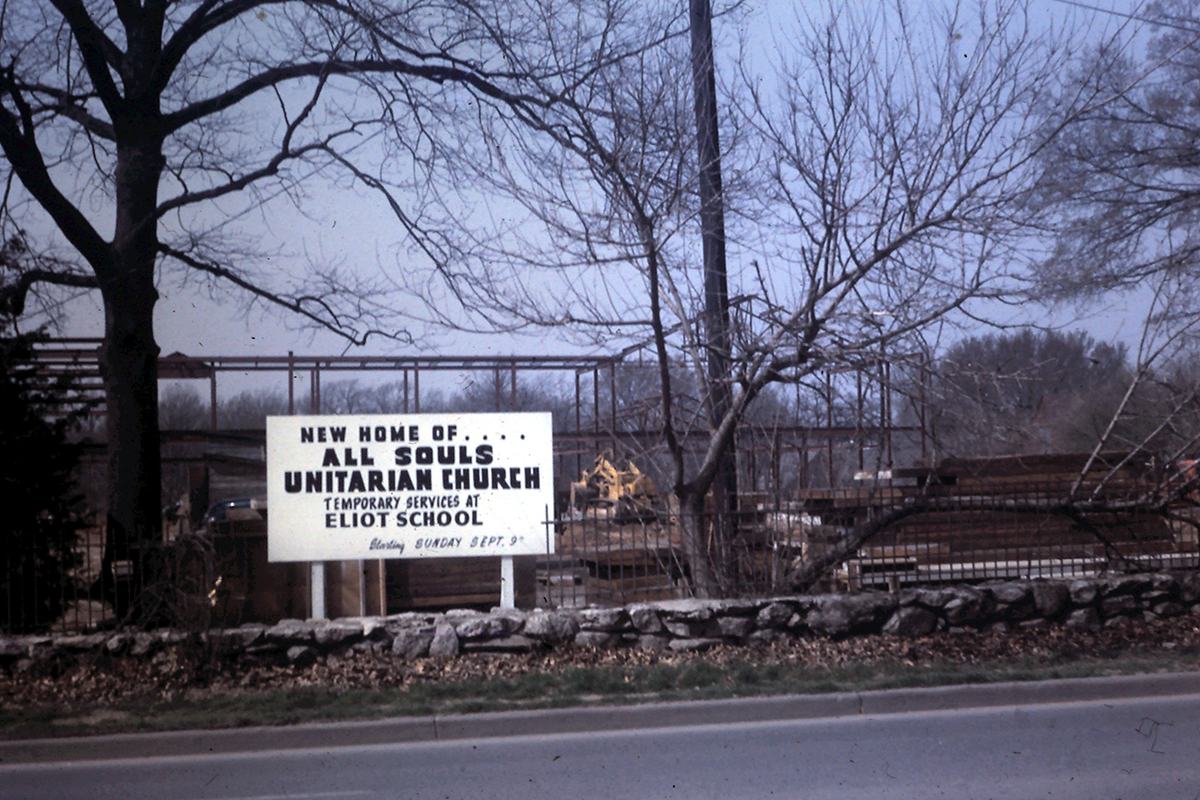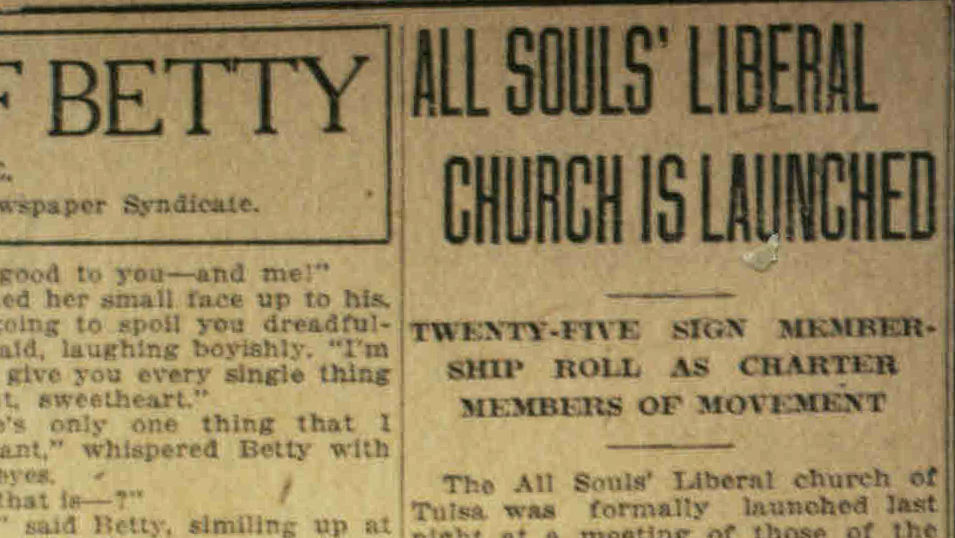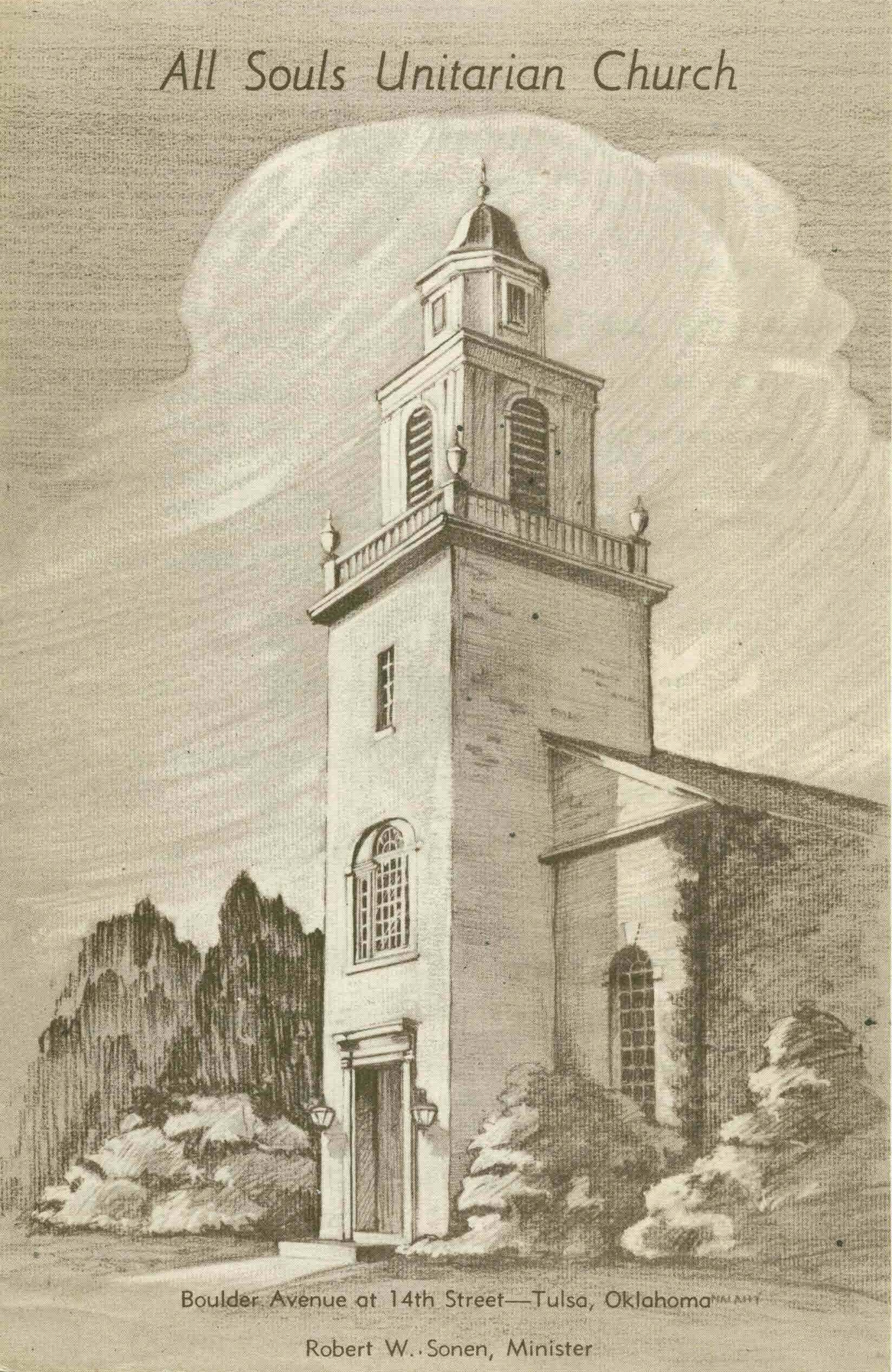“All Souls Unitarian Church in Tulsa is the story of people bearing the light of religious freedom in a city that is known for religious orthodoxy. It is a church that has always drawn city leaders from the fields of politics, business, education, health care, law, the arts and more. It is a community that has never been afraid to take risks or face controversy for the cause of freedom. It is a living tradition that grows with each generation.”
— Rev. Dr. Marlin Lavanhar, All Souls Senior Minister
How It All Began
During Tulsa’s oil boom days of the early twenties, W.R. Holway, the MIT engineer and soon-to-be co-founder of All Souls was charged with bringing fresh, clear water to the burgeoning oil boom town. Opposed to Holway’s proposal to bring water from Spavinaw, was Richard Lloyd Jones, who owned and operated the Tulsa Tribune newspaper. Jones purchased the paper from Charles Page, founder of the city of Sand Springs, who had used the newspaper to promote his plan for the City of Tulsa to obtain its water from Shell Creek, near Sand Springs, rather than from Spavinaw in eastern Oklahoma. They later collaborated to bring a Unitarian church to Tulsa.
The First Meetings
The first meetings were held at the home of Richard Lloyd Jones, a long-time newspaperman. Jones ran an ad in his paper, inviting all who were interested in forming a liberal church to come to a meeting at his home in Owen Park.
Everything was ready for the guests and Richard was watching out the window to see who—if anyone—would show up. A cab pulled up in front of the house, and a man got out whom Jones recognized from his time covering a famous murder trial. That man was Albert T. Patrick, and he had been accused in the murder of William Marsh Rice, the founder of Rice University in Houston.
Jones had to decide in that moment whether this was truly to be the “Church of All Souls,” or if he was going to turn the man away. He chose to open the door, and Mr. Patrick became a charter member and a dedicated leader of the congregation, even serving a term as treasurer.
Old City Hall
All Souls first held Sunday morning services at the site of the old City Hall, 124 East 4th Street in downtown Tulsa. It’s here that the small group of Unitarians were led by the Rev. Thomas Byrnes of Oklahoma City, who drove his Model T over rutted roads to serve our fledgling congregation. Hope Holway, wife of Bill Holway, played what she called "the most abused piano in town."
The Signing of the Charter
On March 28, 1921, twenty-seven people gathered for dinner at the YWCA building at 5th & Cheyenne. After much discourse (particularly on the part of Mr. Jones, according to one attendee), they signed our charter to found All Souls Liberal Church. The feeling was that the name “liberal” would be more widely accepted in Tulsa than Unitarian at the time.

All Souls and Tulsa in the 1920s
Five weeks after the founding of All Souls, on May 31 of 1921, the Tulsa Tribune published a story describing the alleged assault of a white woman by a young black man. It is thought that in the same edition, the paper had an editorial warning of a potential lynching of the accused. However, there are no known copies of the editorial and some argue that it did not exist. Others believe the disappearance of the editorial is a sign that someone in power at the paper wanted it to disappear. Most histories of the riot mention the editorial and make the case that the Tribune was an instrumental force in the devastating tragedy—helping incite the atmosphere that led to the violence now known as the Tulsa Race Massacre.
Editorial or not, the racist views and writings of Richard Lloyd Jones, the co-founder of All Souls, remind us that subscribing to liberal religious ideas does not automatically make someone ethical and just. We all must stand guard over our prejudices and the impact of our words and actions.
Our First Minister: Dr. James Kennedy
We soon had a minister, a new Meadville Theological School graduate, Dr. James Kennedy (not to be confused with the Tulsa founder of the same name). The congregation met both in his home and at the Parish House at 15th and South Quaker, where there was also our first wayside pulpit—a sign with quotes to inspire the community at large. In February of 1922, we were invited to meet at the original location of Temple Israel at 1316 South Cheyenne Avenue.
Rev. Kennedy left in the spring of 1922, to be followed in the fall of 1922 by Dr. Fred Line.
A Growing Congregation
As our congregation grew, we needed more space. All Souls made an arrangement with the owner of The Majestic Theatre, which was located at 406 South Main. All Souls agreed to clear out of the building in time for the Sunday matinee to start, and was allowed to use the theater's pipe organ!
The Majestic Theatre served as our worship space for six years, from 1923-1930. It was there that the church school began.
Rev. Line left in 1925, and was soon replaced by Rev. John Evans, who began to build an audience. Attendance grew to over 125, and it became clear we would soon be ready to build our own place.
Evans left in 1928 and Rev. George Patterson, Director of Ministry for the American Unitarian Association, served the remainder of that year. He was followed by Rev. Alfred Von Stilli.
A Mrs. Waring wrote to the new minister:
“We are building our organization not for our present pleasure, not even for our present needs, but for the future outlook of our young people; to provide them with a religion and a social life in agreement with the discoveries of modern science; a religion of which they will have to unlearn nothing as they grow older; a religion which will stand as true and open-minded and free no matter what facts are brought into contact with it, and a growing religion which will grow with their growth.”
A Home of Our Own
At the height of the Great Depression, the brave souls undertook construction of their own building. On January 2, 1930, twenty-five members voted to build a New England style church, which was dedicated on December 7, 1930.
Jack Sherwood traveled to Boston to secure financial support from the American Unitarian Association (AUA). Richard Lloyd Jones helped with fundraising, soliciting over 200 friends and acquaintances to help out, and receiving donations from Waite Phillips, C. C. Cole, J.A. Hull and other prominent Tulsans who were not members.
The Next Twenty-Five Years
In 1939, Rev. Von Stilli was called to help the church in Oklahoma City, and Dr. Patterson returned to serve for the duration of the war. In February 1944, members voted to call Robert Sonen who, with his wife Olive, personally ushered in the baby boom with three children of their own. A separate parsonage was purchased to house their growing family, and every available space was used to house the growing church school.
By 1951, we had outgrown this space and were looking at options. Member Jean Shields remembers being “packed into rooms in the old house” on Sundays. Since a buyer for a church building seemed unlikely, plans were made to expand onto the lot next door with a three-story addition. The lot was purchased, and fundraising for expansion commenced.
Then, In November 1955, an opportunity to move arose when Kenneth Crouch announced that there was a good prospect for a buyer for the 14th Street Church. Warren Petroleum wished to build across the street to the north, but Mrs. Fitzgerald’s Funeral Home was in the way. Crouch worked out a transaction in which Warren Petroleum would buy the church building and install the funeral home there, and the church would receive the money to purchase another site.
On November 21, 1955, members voted to sell—140 votes in favor, seven against. The end of that church year was the last in the downtown building. On the final Sunday, members gathered, and at the end of the service, Mrs. Lena Pratt Mann, the oldest member at the time, took a lighted candle from the chancel and led the congregation out.

This information was compiled by our volunteers and staff, and is contained in the All Souls History Tour, offered at various times throughout the year.
More recent history is chronicled in our 2012 publication, Love is the Spirit of This Church, published by All Souls' Jenkin Lloyd Jones Press. You can find the book in Sonen Library, and some copies may be available for purchase.



